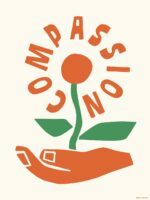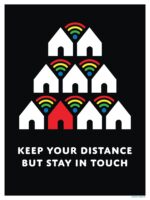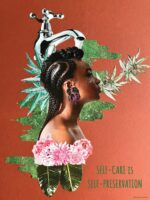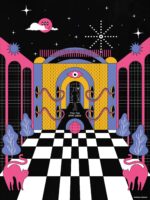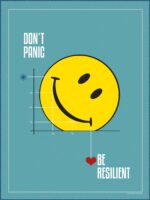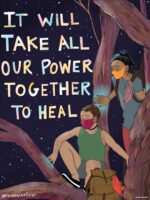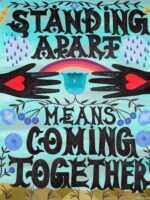
Welldoing ToolWelldoing Tool
Mapping Belonging
Contributed by en.v (Kuwait)
“Mapping Belonging” is a social cartography exercise that consists of identifying the different emotions that we associate with the different places where our lives (and the lives of other members of our society) take place. It encourages us to explore, from a place of curiosity, our conceptions of identity, belonging, difference and otherness, and gain deeper insights about our individual and collective lived experiences.
It is a tool that serves as a participatory and experimental research method, while also creating a positive impact on the participants in the process of being implemented: it increases our ability to understand social diversity and empathize with other perspectives and values.
Collective emotional mapping takes us out of the bubble of our individual worldview and shows us that we are part of a larger system where many different people find many different sources of meaning. A higher sense of self-awareness and social awareness are both key ingredients to the process of strengthening community bonds from a place of compassion and resilience, and they establish the grounds for positive interpersonal interaction and transformative change.
en.v has been working with its AWAKEN Community of Practice to further refine and test out this tool, and facilitate it across diverse communities in Kuwait, collecting valuable data and promoting self-reflection and connection.
How to Practice
What you will need: a map of your location, coloured stickers corresponding to the emotions chart, cards, and writing materials
Step 1
Welcome participants into the space and tell them a little bit about the exercise. Facilitators can add whatever they consider suitable to this explanation and refer to examples from their personal experiences.
Step 2
Introduce a warm-up / ice-breaker. Before the mapping activity, invite the group to do a short exercise to warm-up and break the ice for about 10 minutes. The activity is called “story-slam”: participants will be asked to get into two lines facing each other and give a 1-minute answer to the person in front of them (at each turn) to the questions that the facilitators will ask out loud. After one minute, one of the lines will move one spot and each participant will be facing someone new and giving an answer to a new question. Facilitators can choose any of the following questions during five rounds:
What is your favourite place in [location]?
Where do you live and have you ever lived in that area?
What place in [location] brings up happy memories and why?
Where do you go when you want to relax?
Where in [location] do you eat the best food?
What are your favourite family spaces?
What is a space that doesn’t feel like [location]?
Are there places in [location]that you avoid? Which ones and why?
What are the places you frequented as a child?
If you have a friend coming to visit [location] for the first time, where would you take them and why?
Step 3
Begin the Mapping Belonging exercise. Start by explaining the activity: it’s an exercise that consists of identifying the different emotions that we associate with the different places where our lives take place. Facilitators will ask the participants to look at the map of their location, with its different zones and areas, and identify the places where they feel these emotions:

While looking at the map and identifying the areas where they feel the different emotions (they can choose 3-4 places for each emotion), participants can take coloured stickers that correspond to the emotions and place them on the chosen areas of the map. This part of the activity can last 10-15 minutes.
Step 4
Go deeper with story cards. After they have finished placing the stickers in the corresponding areas, facilitators will give them a set of cards that contain some questions about the mapped emotions and ask them to write their answers on the cards. Encourage participants to keep their answers short and sweet and use only the space on the cards. This part of the activity can last 20-25 minutes.
Step 5
Conclude with a group discussion. After participants are done filling in the cards, host a short collective debrief (5 minutes) around the two following questions:
What did it feel like to place the emotions on the map? Are there any reflections or emotions that this exercise brought up for you?
How can we make spaces in [location] more inclusive?
About en.v
We are a culturally diverse and interdisciplinary team of current and former Kuwait residents and nationals working together to foster a more united, compassionate and resilient society – locally and globally. Over the past decade, we have been working with and building bridges between a wide array of stakeholders, including corporates, governmental, intergovernmental and international institutions, foundations, educators, youth, civil society organizations and migrant community groups. Leveraging our own and our partners’ learnings, experience and networks, we design and facilitate inclusive and participatory processes that support the development of more equitable solutions and narratives. Specifically, we:
Develop training and programming which promotes informed empathy, critical thinking, and intersectional frameworks
Support the development and institutionalization of more inclusive and equitable processes and policies
Bring together multiple stakeholders to collectively address complex problems, envision possible futures and promote social transformation.

Untitled Untitled
By Members of our Wellbeing in Higher Education Network community
Daniel, Lisa, Jara, Rosalinda, Tania, Mac, and Ken



Haikus & Poems Haikus & Poems
By The Higher Education Network
Get ready to embark on a journey through the poetic expressions of The Higher Education Network‘s annual gathering in Switzerland.
In this collection, you will discover haikus and poems that echo the spirit of intellectual exploration, camaraderie, and the shared commitment to the future of wellbeing in education. Each syllable is a brushstroke, painting a picture of contemplation, connection, and elevation of the mind. Through verses inspired by the serene landscapes, the vibrant discussions, and the harmonious bonds formed, we invite you to experience the essence of this gathering.
As you immerse yourself in these poetic reflections, may you find inspiration, insight, and a renewed sense of purpose in the pursuit of wellbeing and enlightenment within the realm of education.
















Wellbeing Of The World Wellbeing Of The World
A Global Symphony
“Wellbeing of the World – A Global Symphony” is an international, collaborative music project by composer/inventor Tod Machover and his team at the MIT Media Lab. Over the next two years, the music project will sample perspectives on inner, organisational, societal and planetary wellbeing at the regional Hearth Summits, as well as more generally, all leading up to the global Hearth Summit in 2025. This uniquely exciting initiative aims at exploring through sounds of all kinds how different cultures and communities explore the journey of wellbeing for individuals, organisations, communities, societies and the planet, for the current moment as well as for the future.

With “Wellbeing of the World — A Global Symphony,” Tod Machover, the MIT Media Lab, The Wellbeing Project, and the regional Hearth Summits are launching a new initiative whose ambition is to collect sounds, voices and music from the different regional and global summit locations to create a true world symphony, the very first of its kind. The project is designed to explore and promote wellbeing by weaving together the unique sounds that the different cultures and places around the world select to explore the journey of wellbeing for individuals, organisations, communities, societies and for the planet.
“Wellbeing of the World — A Global Symphony” will culminate at the 2024 global Hearth Summit, with a headline musical performance that brings together this collective and global artistic expression of wellbeing, and will also be expressed in a first-ever, AI-generated “flowing symphony” that will constantly evolve, inviting sonic input and listener preference far into the future.
Throughout the two-year journey, local communities from all the regional and global Hearth Summit locations will be invited to help create this collective story, using software specially designed at the MIT Media Lab.
Sounds can come from professional musicians and amateurs, from people of all ages and backgrounds, and from anything in the environment (human-created or not) that conveys a vivid sense of place and of purpose.
As the sounds are collected, using research currently underway at the MIT Media Lab and under Tod Machover’s creative supervision, the process will combine, contrast and coordinate them to dramatize individual voices as well as collective harmony. The result will be an ever-changing musical piece: the Wellbeing of the World Symphony, a sonic portrait of wellbeing around the world.
Wellbeing Of The World Wellbeing Of The World
At the Regional Hearth Summits
Meet Tod at The Wellbeing Summit 2022
The City Symphonies Model
The model which brought this highly original initiative to life is to be found in the City Symphonies, a project developed by Machover and the MIT Media Lab since 2013, which invited citizens of a specific city from all ages and backgrounds to work together to create its sonic portrait, constructed from contributed sounds ranging from musical to noise, composed to “found,” and from expert to anything. This project was also brought to Bilbao on the occasion of the 2022 Global Wellbeing Summit for Social Change. City Symphonies have not only resulted in powerfully memorable musical compositions, but also have built extraordinary community and cultivated creativity in radical new ways.
About Tod Machover About Tod Machover

Tod Machover, composer and inventor, is Muriel R. Cooper Professor of Music & Media at the MIT Media Lab, where he is also Director of the Opera of the Future Group and Academic Head.
He has been called “America’s most wired composer” by The Los Angeles Times, and “a musical visionary” by The New York Times, and is widely celebrated for inventing new technologies that expand music’s potential for emotional expression, for creating community, and for enhancing health and wellbeing.
Tod Machover’s work has been awarded numerous prizes and honors from organizations such as the American Academy of Arts and Letters, the Fromm and Koussevitzky music foundations, the National Endowment for the Arts, the German and French ministries of culture, the World Technology Network, and Musical America (that named him Composer of the Year in 2016). He has been commissioned and performed by many of the world’s most prominent cultural organizations, including Yo-Yo Ma, the Pompidou Center (Paris), the Philadelphia Orchestra, the Opéra de Monte-Carlo, The Kronos Quartet, and many others. Machover is especially recognized for his groundbreaking operas, including the audience-interactive Brain Opera, the “robotic” Death and the Powers (Finalist for the Pulitzer Prize), and his current opera project, The Overstory, based on Richard Powers’ Pulitzer Prize winning novel about trees and the urgency of recalibrating the relationship between humans and the non-human world.

TWBS 2022 PERFORMANCES TWBS 2022 PERFORMANCES
Art In Motion
The stage came alive with mesmerizing performances that blended artistry and wellness, captivating audiences throughout The Wellbeing Summit 2022. Dance troupes, theater groups, and musicians graced the summit, delivering awe-inspiring performances that explored the emotional and physical aspects of wellbeing. Through their art, performers expressed the transformative power of movement, music, and storytelling, leaving the audience inspired and uplifted.
I Am Enough – Justin Michael Williams
Songs Of Solomon – Bishop Chantel Wright
The Silkroad Ensemble
Rituals Of Life – Aakash Odedra
Art x TWBS 2022 Art x TWBS 2022
PERFORMANCES, EXHIBITIONS & MORE
The Wellbeing Summit 2022 was an extraordinary convergence of art and wellness, where creativity took center stage to inspire, engage, and uplift attendees. This unique event celebrated the fusion of art and wellbeing, showcasing a diverse range of art exhibitions, performances, and immersive experiences. Let’s take a closer look at some of the remarkable artistic endeavors that unfolded during The Wellbeing Summit 2022.
Art x Wellbeing Art x Wellbeing
Cultivating Wellbeing Through Creativity
Art is a powerful tool for self-expression, fostering self-discovery and understanding. It also sparks empathy, compassion, and social change, promoting dialogue among diverse communities. Whether creating or appreciating art, explore this section for inspiration and discover how art can enrich your life and shape a brighter future.
ART X WELLBEING ART X WELLBEING
Voices of Wellbeing | Dr. Sará King Voices of Wellbeing | Dr. Sará King
“If you have a body, then you deserve wellbeing”
Dr. Sará King- speaker at The Wellbeing Summit for Social Change– is a neuroscientist, political and learning scientist, education philosopher, social-entrepreneur, public speaker, and certified yoga and mindfulness meditation instructor. She specializes in the study of the relationship between mindfulness, art, complementary alternative medicine, community health and social justice.
She joins us to share the importance of sectors and institutions working together to support the psyhiological, psychological and relational wellbeing of our global societies. She also delves into how art can provide a path forward and ways to heal for those working within movements for social justice, as well as some of the neuroscientific research that is out there to support this.














